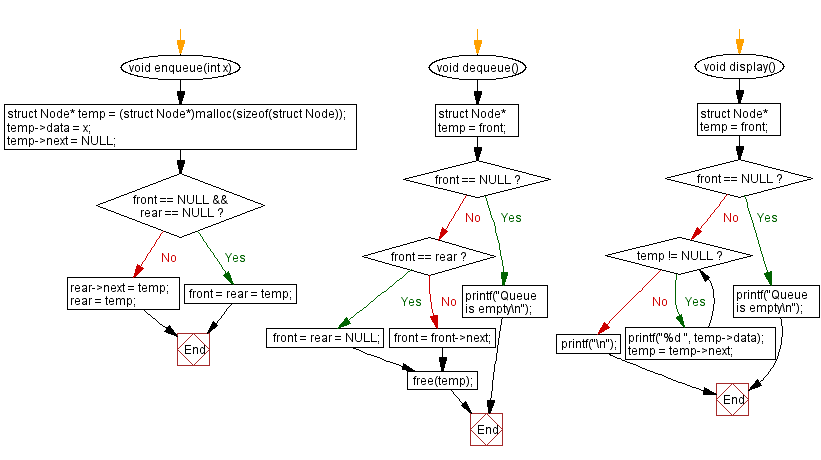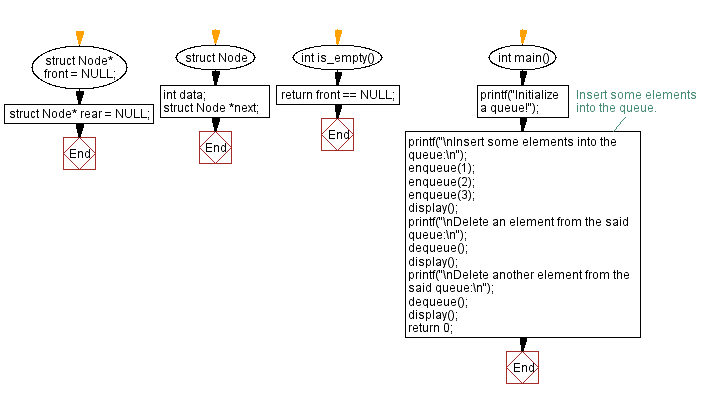C Exercises: Remove an element from a queue (using an linked list)
4. Array Queue Deletion Function
Write a C program to implement a queue using a linked list. Create a function that removes an element from the queue.
Sample Solution:
C Code:
#include <stdio.h>
#include <stdlib.h>
// Define a structure for a node in the queue
struct Node {
int data;
struct Node *next;
};
struct Node* front = NULL; // Declare a pointer to the front of the queue
struct Node* rear = NULL; // Declare a pointer to the rear of the queue
// Function to insert an element into the queue
void enqueue(int x) {
// Allocate memory for a new node
struct Node* temp = (struct Node*)malloc(sizeof(struct Node));
temp->data = x; // Assign data to the new node
temp->next = NULL; // Set the next pointer of the new node to NULL
// Check if the queue is empty
if (front == NULL && rear == NULL) {
front = rear = temp; // If empty, set both front and rear to the new node
return;
}
rear->next = temp; // Otherwise, link the new node to the rear of the queue
rear = temp; // Update the rear pointer to the new node
}
// Function to remove an element from the queue
void dequeue() {
struct Node* temp = front; // Store the front node in a temporary variable
// Check if the queue is empty
if (front == NULL) {
printf("Queue is empty\n"); // Print error message if empty
return;
}
// Check if there's only one node in the queue
if (front == rear) {
front = rear = NULL; // If yes, set both front and rear to NULL
} else {
front = front->next; // Otherwise, move front to the next node
}
free(temp); // Free memory allocated for the removed node
}
// Function to display the elements in the queue
void display() {
struct Node* temp = front; // Initialize a temporary pointer to traverse the queue
// Check if the queue is empty
if (front == NULL) {
printf("Queue is empty\n"); // Print message if empty
return;
}
// Traverse the queue and print each element
while (temp != NULL) {
printf("%d ", temp->data); // Print the data of the current node
temp = temp->next; // Move to the next node
}
printf("\n"); // Print a newline after displaying all elements
}
// Function to check whether the queue is empty
int is_empty() {
return front == NULL; // Return 1 if front is NULL (indicating an empty queue), otherwise return 0
}
int main() {
printf("Initialize a queue!"); // Print message to indicate initializing a queue
// Insert some elements into the queue.
printf("\nCheck the queue is empty or not? %s\n", is_empty() ? "Yes" : "No"); // Check if the queue is empty
printf("\nInsert some elements into the queue:\n"); // Print message to indicate inserting elements into the queue
enqueue(1); // Insert element 1 into the queue
enqueue(2); // Insert element 2 into the queue
enqueue(3); // Insert element 3 into the queue
display(); // Display the elements of the queue
printf("\nInsert another element into the queue:\n"); // Print message to indicate inserting another element
enqueue(4); // Insert element 4 into the queue
display(); // Display the elements of the queue
printf("\nCheck the queue is empty or not? %s\n", is_empty() ? "Yes" : "No"); // Check if the queue is empty
return 0; // Return from the main function
}
Output:
Initialize a queue! Insert some elements into the queue: 1 2 3 Delete an element from the said queue: 2 3 Delete another element from the said queue: 3
Flowchart


For more Practice: Solve these Related Problems:
- Write a C program to implement a double-ended queue using an array that supports conditional deletion based on value.
- Write a C program to design a fixed-size array queue that records each deletion operation into a log file.
- Write a C program to implement an array queue where the deletion function returns both the deleted element and its index.
- Write a C program to implement an array-based queue that removes an element only if it satisfies a given predicate.
Go to:
PREV : Queue Linked List Basic Operations.
NEXT : Queue Element Counting.
C Programming Code Editor:
Have another way to solve this solution? Contribute your code (and comments) through Disqus.
What is the difficulty level of this exercise?
Test your Programming skills with w3resource's quiz.
